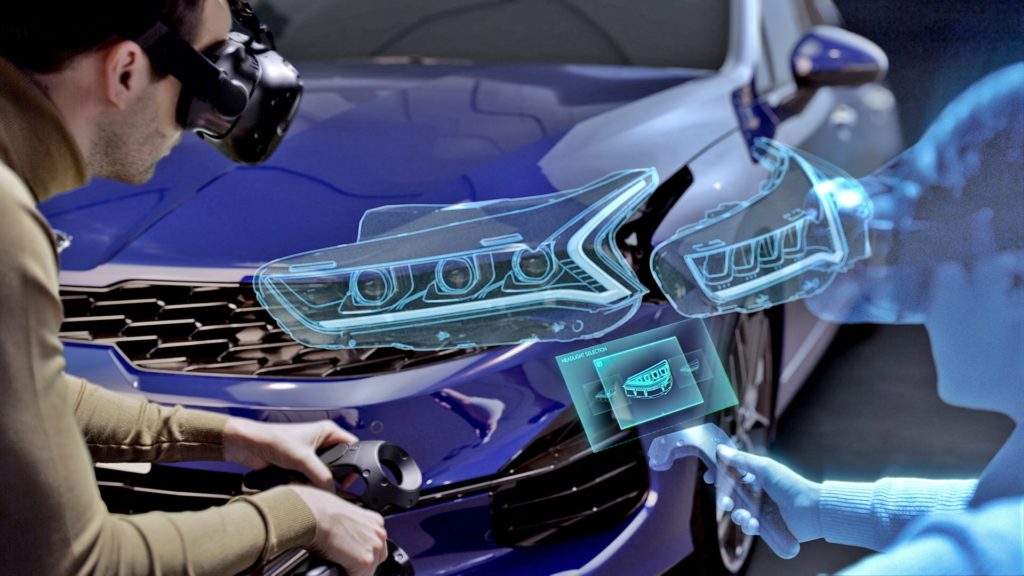
Looking into the Future: Exploring Apple’s Vision Pro and understanding the future of AR and VR in the Automotive Industry
The automotive industry is on the cusp of a technological revolution, and the recent launch of Apple’s AR/VR headset named Vision Pro could be a significant milestone in this evolution. How? With the immersive capabilities of augmented reality (AR) and virtual reality (VR), the technology used to create the Vision Pro headset holds the potential to revolutionize the automotive sector, offering new possibilities and utilities for both drivers and passengers. Augmented reality in some form has already shown its prowess in enhancing the driving experience, and now, with the evolution of AR/VR technology, the integration of virtual elements with the real-world environment is set to reach new heights. From transforming navigation and wayfinding to redefining car design, maintenance, and even driver training, the applications of AR/VR technology in the automotive industry are boundless.
In recent years, augmented reality (AR) technology has emerged as a game-changer in various industries, from gaming and entertainment to healthcare and education. However, one sector that is particularly poised to benefit from the immersive capabilities of AR is the automotive industry. By blending virtual elements with the real-world environment, AR/ VR technology would be revolutionizing the way we interact with cars, opening up a world of exciting possibilities for both drivers and passengers. Gone are the days when augmented reality was solely associated with futuristic concepts seen in movies. Today, AR headsets are making their way into our daily lives, seamlessly integrating with the automotive ecosystem. These cutting-edge technologies are reshaping the future of transportation as we know it. So fasten your seat belts and join us on this exciting journey as we uncover the ways in which AR headsets are set to transform the automotive landscape.
1. Heads-up Display (HUD): Heads-up Display (HUD) technology is revolutionizing the way drivers interact with their vehicles. With the integration of AR headsets, important information can be projected directly onto the car’s windshield, creating an immersive heads-up display. This means that drivers no longer need to glance down at traditional dashboards or navigation screens to access crucial data. Instead, they can keep their eyes focused on the road ahead while effortlessly viewing real-time information like speed, navigation instructions, and safety alerts overlaid on the windshield. By eliminating the need for constant shifts in focus, HUD-enabled AR headsets enhance safety and situational awareness, allowing drivers to stay connected with vital information while maintaining their attention on the road.

2. Navigation and Wayfinding: Navigation and wayfinding have become more intuitive and immersive with the integration of AR headsets in cars. By overlaying virtual arrows, directions, and other navigational cues onto the real-world view, these headsets provide drivers with real-time and contextually relevant information. Gone are the days of constantly glancing at traditional GPS screens or smartphone displays, as AR headsets offer a seamless and hands-free experience. Drivers can simply follow the augmented reality instructions projected onto their field of view, allowing for better focus on the road ahead. This technology not only enhances safety but also provides a more engaging and user-friendly navigation experience, ensuring drivers reach their destinations with ease and confidence.
3. Virtual Test Drives: The launch of Apple’s AR/VR headset, the Vision Pro, brings exciting possibilities to the automotive industry, particularly in the realm of virtual test drives. With AR headsets, potential car buyers can now experience different car models and configurations without the need to physically visit a dealership. The immersive nature of AR allows users to explore the interior and exterior of virtual vehicles, change colors, customize features, and even virtually “test drive” the car. This technology provides a unique opportunity to gain a better sense of a vehicle’s performance, handling, and overall driving experience. By enabling potential buyers to virtually interact with cars, AR headsets like the Vision Pro empower consumers to make informed decisions from the comfort of their homes, ultimately transforming the car buying process.

4. Gamification: AR headsets bring a new level of entertainment to the driving experience through gamification. Long drives or traffic situations can be transformed into engaging and interactive adventures. Passengers can now participate in multiplayer AR games that seamlessly blend real-world elements and environments with virtual gameplay. Imagine embarking on a treasure hunt where the physical landmarks along the road become clues and obstacles in the game. Or competing with fellow passengers in a virtual racing game where the car’s speed and movement impact the gameplay. These immersive gaming experiences not only make the journey more enjoyable but also foster social interaction and friendly competition among passengers. AR gamification in cars opens up a realm of possibilities for turning mundane trips into thrilling adventures, making every moment on the road an opportunity for entertainment and shared experiences.

5. Maintenance and Repairs: AR headsets are revolutionizing the field of automotive maintenance and repairs. Mechanics and technicians can now rely on these devices to access digital repair manuals, schematics, and step-by-step instructions without the need for physical documents. The AR headset overlays relevant information directly onto the technician’s field of view, ensuring hands-free access to crucial guidance while working on complex repairs. This technology greatly enhances efficiency and reduces the risk of errors by providing real-time visual cues and annotations, making it easier for technicians to identify and locate components, follow procedures, and perform intricate tasks with precision. AR headsets empower technicians with a wealth of knowledge at their fingertips, revolutionizing the way maintenance and repairs are conducted in the automotive industry.
6. Design and Prototyping: AR headsets are reshaping the landscape of automotive design and prototyping. Designers and engineers now have the ability to leverage these devices to visualize and evaluate virtual car designs in an unprecedented way. By overlaying virtual prototypes onto real-world environments, AR headsets enable professionals to assess the appearance, aerodynamics, and functionality of vehicles with a heightened sense of immersion and realism. Designers can examine how the car looks from different angles, how it fits within its surroundings, and how its lines and curves interact with the environment. They can even simulate driving scenarios to evaluate ergonomics and performance. This technology revolutionizes the design process, allowing for more efficient iterations and informed decision-making, ultimately leading to the creation of cutting-edge and visually stunning automobiles.

7. Driver Training: Driver training is being revolutionized by the integration of AR headsets. These devices offer a safe and controlled environment for learners to practice their driving skills and gain valuable experience. AR headsets can simulate various scenarios, hazards, and road conditions, allowing aspiring drivers to navigate through challenging situations without the risks associated with real-world roads. Learners can receive real-time feedback, receive instructions, and improve their decision-making abilities in a virtual setting. This technology enhances the effectiveness of driver training programs, providing a hands-on and immersive learning experience that complements traditional classroom and behind-the-wheel instruction. AR headsets empower learners to build confidence, develop critical skills, and make better judgments, ensuring they are well-prepared and equipped for the complexities of driving on actual roads.
With a wide range of cutting-edge applications that improve the driving experience, design procedures, maintenance, and training, augmented reality (AR)/virtual reality (VR) technology will emerge as a disruptive technology in the automobile sector. We can anticipate even more intriguing potential and applications for augmented reality in the automobile sector as technology develops. These applications, combined with the release of the Apple’s Vision Pro headset and the technological advancements that came with it, marks an exciting new chapter in the convergence of technology and transportation. The future of transportation would be driven by augmented reality (AR), making our rides more interesting, educational, and entertaining through personalized driving experiences as well as improvements in safety and efficiency. A new era of automobile innovation is coming, so embrace the augmented reality revolution.












